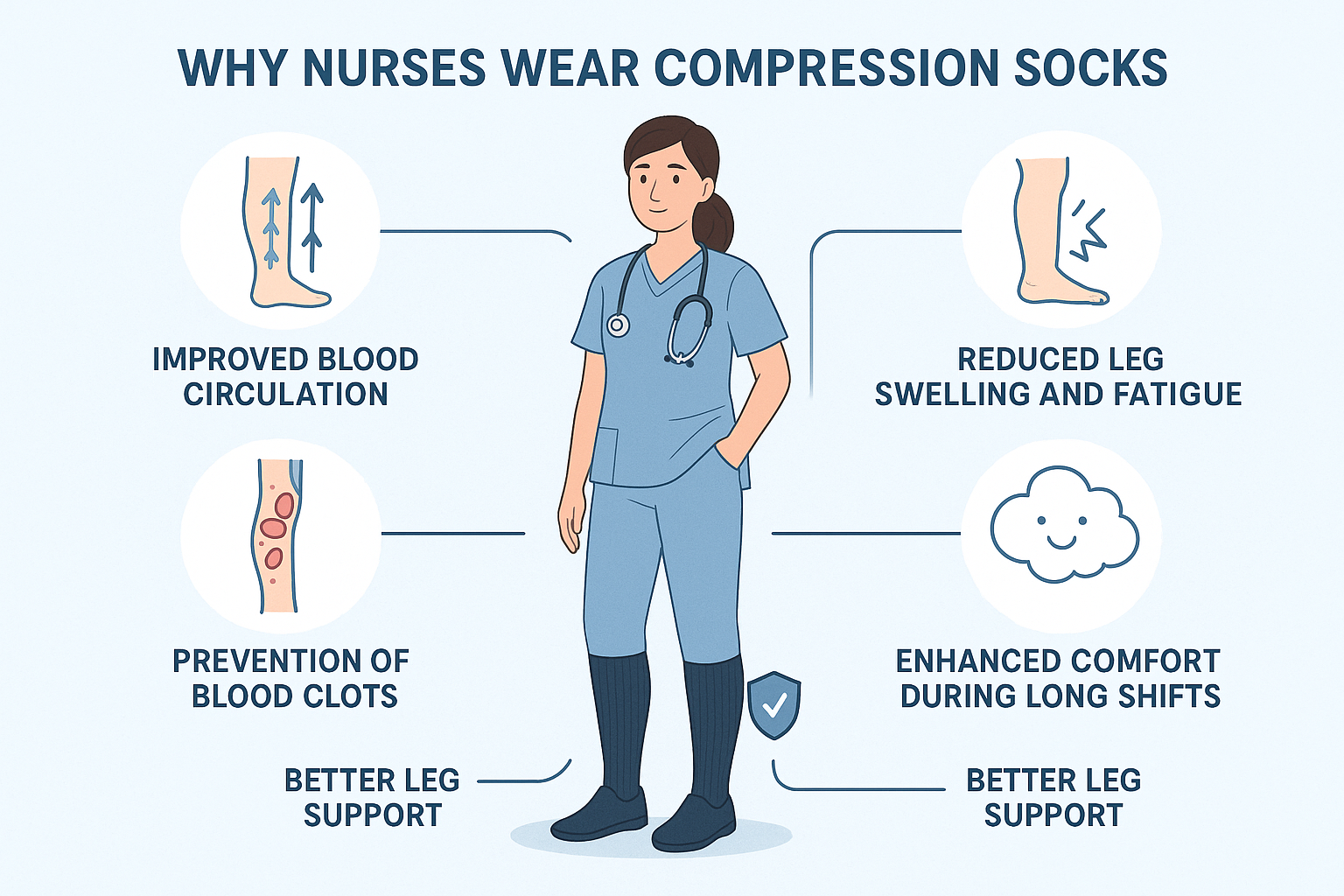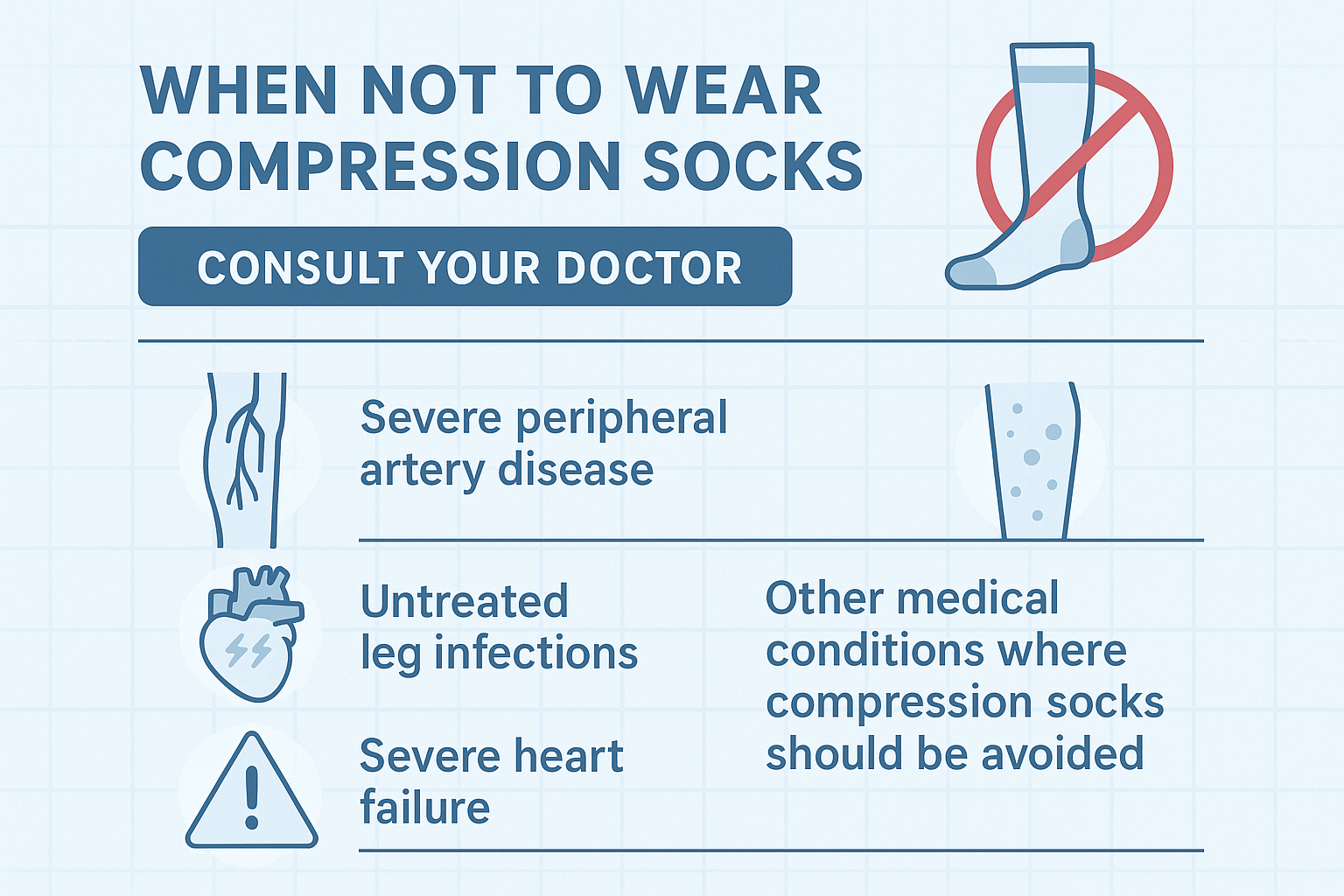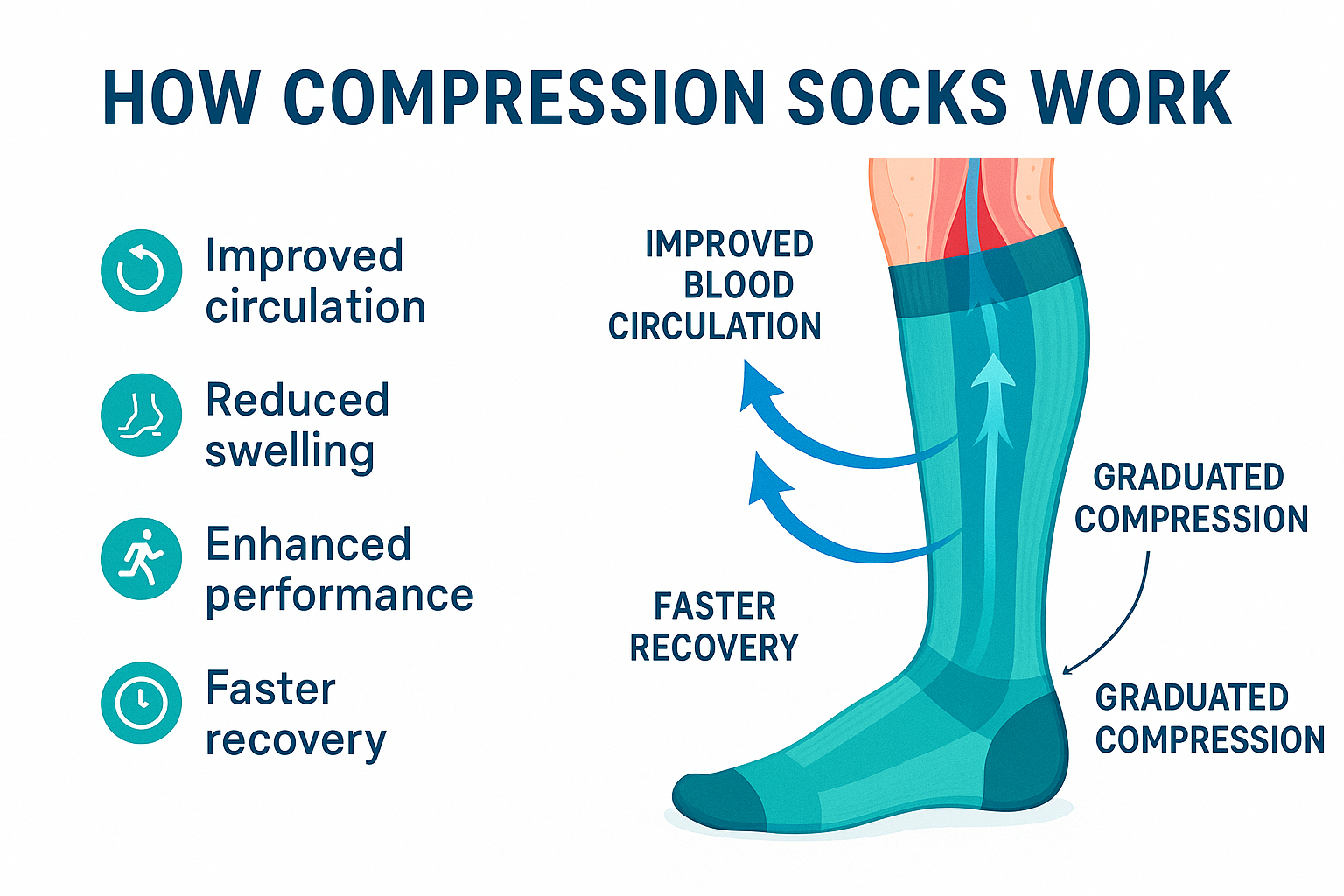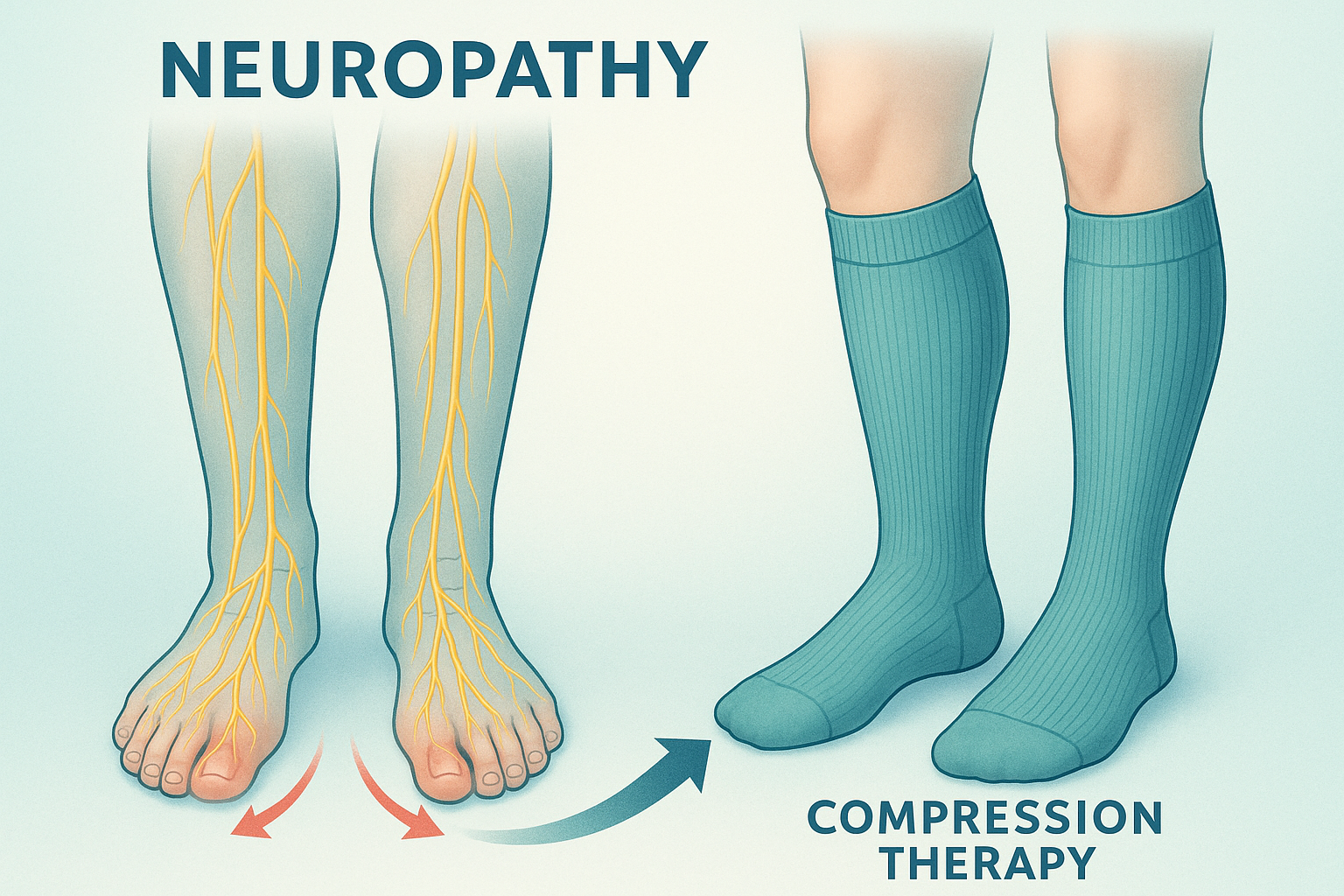Can You Wear Compression Socks to Bed?
Compression socks are widely recommended for improving circulation, reducing swelling, and preventing blood clots during the day. But many people wonder: can you wear compression socks to bed? While compression socks are safe for most people, overnight use depends on your health, comfort, and whether your doctor recommends it.
In this guide, we’ll explain the pros and cons of wearing compression socks at night, when it may be beneficial, who should avoid it, and the best alternatives for healthy circulation while you sleep.
Understanding How Compression Socks Work
Compression socks use graduated pressure, which is tightest at the ankle and gradually loosens higher up the leg. This pressure helps blood move upward, prevents fluid from pooling in the feet and ankles, and reduces swelling.
During the day, gravity naturally pulls blood downward, which is why people wear compression socks while standing, sitting, or traveling. At night, when you’re lying flat, circulation doesn’t face the same gravitational challenge—so the role of compression changes.
Is It Safe to Wear Compression Socks to Bed?
The short answer: sometimes. For most healthy individuals, it’s unnecessary to wear compression socks while sleeping. Daytime use is usually enough to gain their benefits. However, in certain cases, overnight wear can be safe and even beneficial.
Scenarios where wearing compression socks to bed may be recommended include:
- Medical advice: A doctor prescribes overnight use for circulation problems or post-surgery recovery.
- Persistent swelling: When daytime compression isn’t enough to reduce fluid buildup.
- Pregnancy: Some expecting mothers wear light compression at night to ease swelling discomfort.
- Lymphedema management: For chronic conditions requiring round-the-clock support.
Benefits of Wearing Compression Socks Overnight
Depending on your health and needs, sleeping in compression socks may provide:
1. Reduced Morning Swelling
If you often wake up with puffy ankles or feet, compression socks may help keep swelling under control through the night.
2. Continuous Circulation Support
For people with vein disorders or poor circulation, overnight use maintains consistent blood flow and reduces pooling.
3. Recovery for Athletes
Some athletes wear compression socks to bed after intense training to promote muscle recovery, reduce soreness, and improve oxygen delivery to tissues.
4. Pregnancy Comfort
Pregnant women may find relief from swelling and leg pain by wearing mild compression socks while sleeping.
Risks of Wearing Compression Socks to Bed
Although compression socks are safe for most people, there are potential drawbacks to wearing them at night:
- Unnecessary pressure: Because circulation is different while lying flat, overnight compression may not be needed.
- Discomfort: Some people find compression socks too tight for restful sleep.
- Skin issues: Wearing socks for 24 hours straight may cause irritation or dryness.
- Improper fit: Socks that are too tight or the wrong size can restrict circulation instead of helping it.
For most individuals, wearing compression socks only during the day is sufficient.
Expert Recommendations
Doctors generally advise wearing compression socks during waking hours when circulation struggles most due to gravity. This includes:
- Long work shifts on your feet
- Sitting for extended periods (like office jobs or travel)
- Exercise and athletic activity
- Pregnancy or recovery from surgery
Overnight use is usually only recommended if prescribed for medical conditions or persistent swelling. Otherwise, most people should remove them before bed to let their skin breathe and avoid discomfort.
Who Should Avoid Wearing Compression Socks to Bed?
Certain people should not use compression socks overnight unless specifically instructed by a doctor:
- Those with peripheral arterial disease (PAD), where compression can reduce blood supply.
- Individuals with nerve disorders (like neuropathy), who may not feel if socks are too tight.
- People with skin conditions aggravated by prolonged compression, such as eczema.
Alternatives to Wearing Compression Socks at Night
If you want the benefits of better circulation without sleeping in compression socks, try these alternatives:
- Leg elevation: Sleeping with your legs slightly raised helps fluids drain naturally.
- Gentle stretches: Doing light leg stretches before bed can improve circulation.
- Massage: A light calf and foot massage reduces swelling and relaxes muscles.
- Hydration: Drinking water and limiting salt intake prevents fluid retention overnight.
Tips for Safe Overnight Use
If you do decide (or are advised) to wear compression socks to bed, follow these best practices:
- Choose light to moderate compression levels (8–20 mmHg).
- Make sure your socks fit properly and aren’t overly tight.
- Pick breathable, moisture-wicking fabrics to prevent irritation.
- Check your legs daily for any redness, irritation, or pressure marks.
Higher compression levels (20–30 mmHg or above) should only be worn overnight under medical supervision.
Frequently Asked Questions
Can you wear compression socks for 24 hours straight?
It’s not typically recommended. Most people only need compression during the day, but a doctor may suggest overnight use in special cases.
Do compression socks help with restless legs at night?
Some people find relief, but stretching, massage, and hydration are often more effective for restless leg syndrome.
Can pregnant women wear compression socks while sleeping?
Yes, but mild compression is best, and it should be discussed with a healthcare provider.
Are there special socks for overnight wear?
Yes. Some brands design lighter compression socks specifically for night use, but daytime socks are usually enough for most people.
Conclusion: Should You Wear Compression Socks to Bed?
So, can you wear compression socks to bed? The answer depends on your individual needs. For most people, wearing them during the day is enough to prevent swelling, boost circulation, and support comfort. Overnight use may be helpful for pregnant women, athletes, or those with chronic swelling—but it should ideally be guided by a healthcare professional.
If you’re looking to experience the proven benefits of compression therapy for work, travel, exercise, or recovery, explore our full collection here: Shop Green Drop Compression Socks.







